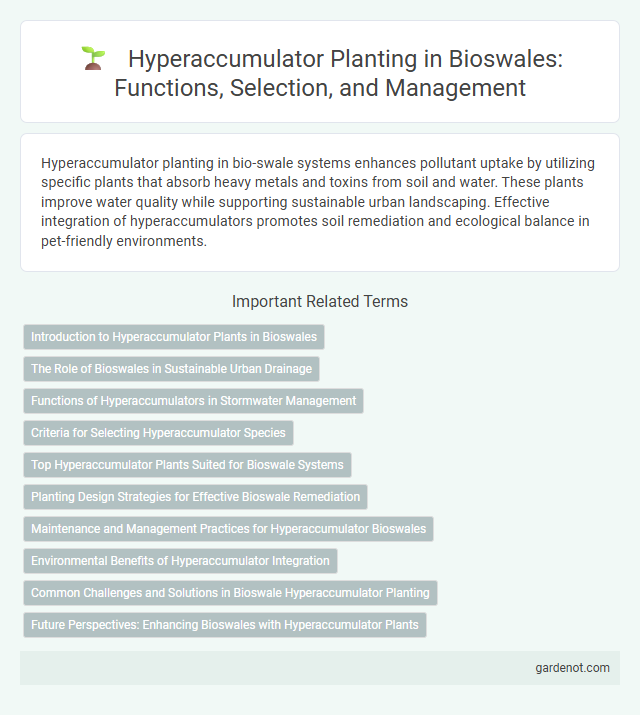Hyperaccumulator planting in bio-swale systems enhances pollutant uptake by utilizing specific plants that absorb heavy metals and toxins from soil and water. These plants improve water quality while supporting sustainable urban landscaping. Effective integration of hyperaccumulators promotes soil remediation and ecological balance in pet-friendly environments.
Introduction to Hyperaccumulator Plants in Bioswales
Hyperaccumulator plants in bioswales are specialized species capable of absorbing high levels of heavy metals and pollutants from contaminated soils and water. These plants enhance the phytoremediation efficiency of bioswales by sequestering toxic substances such as cadmium, nickel, and lead, preventing their spread in urban environments. Selecting hyperaccumulators like Brassica juncea and Pteris vittata optimizes pollutant removal while supporting sustainable stormwater management.
The Role of Bioswales in Sustainable Urban Drainage
Bioswales play a critical role in sustainable urban drainage by integrating hyperaccumulator plants that effectively extract heavy metals and pollutants from stormwater runoff. These plants, such as Pteris vittata and Brassica juncea, enhance contaminant uptake, improving water quality and soil health within urban ecosystems. Incorporating hyperaccumulators into bioswale design supports ecological resilience while mitigating urban water pollution challenges.
Functions of Hyperaccumulators in Stormwater Management
Hyperaccumulators enhance stormwater management by absorbing and concentrating heavy metals and pollutants from runoff, effectively reducing contaminant levels before they reach water bodies. Their deep root systems promote soil stabilization and increased infiltration, mitigating erosion and flooding risks. These plants also improve overall water quality by facilitating phytoremediation processes that degrade organic toxins and support microbial activity in bio-swales.
Criteria for Selecting Hyperaccumulator Species
Selecting hyperaccumulator species for bio-swales requires focusing on heavy metal uptake capacity, growth rate, and adaptability to local soil and climate conditions. Species must demonstrate tolerance to contaminants like lead, cadmium, or arsenic while maintaining robust biomass production. Root structure and compatibility with native ecosystems also influence phytoremediation efficiency and long-term sustainability.
Top Hyperaccumulator Plants Suited for Bioswale Systems
Top hyperaccumulator plants such as Pteris vittata (Chinese brake fern), Thlaspi caerulescens (Alpine pennycress), and Aldrovanda vesiculosa excel in bioswale systems by efficiently removing heavy metals like arsenic, zinc, and cadmium from contaminated runoff. Their exceptional phytoextraction capabilities enhance bioswale performance, improving soil and water quality in urban stormwater management practices. Selecting these species optimizes contaminant uptake while supporting ecosystem health and sustainability.
Planting Design Strategies for Effective Bioswale Remediation
Hyperaccumulator planting in bioswale design enhances heavy metal uptake by selecting species such as Pteris vittata and Alyssum murale, which are known for their phytoremediation capabilities. Strategic arrangement of these plants in layered zones promotes optimal contaminant absorption while maintaining soil stabilization and hydrological function. Incorporating a diversity of hyperaccumulators tailored to site-specific pollutant profiles maximizes bioswale remediation efficiency and long-term sustainability.
Maintenance and Management Practices for Hyperaccumulator Bioswales
Effective maintenance and management of hyperaccumulator planting in bioswales involve regular monitoring of plant health and soil contamination levels to maximize pollutant uptake. Implementing adaptive irrigation schedules and removing accumulated biomass prevent nutrient overload and promote sustained phytoremediation efficiency. Seasonal pruning and timely replacement of hyperaccumulator species enhance bioswale performance by maintaining optimal growth conditions and contaminant absorption capacity.
Environmental Benefits of Hyperaccumulator Integration
Hyperaccumulator plants in bio-swales enhance heavy metal phytoremediation by absorbing and sequestering contaminants from soil and water, improving overall ecosystem health. These plants reduce pollutant bioavailability, mitigating soil and water toxicity while promoting biodiversity in urban and industrial runoff areas. Integration of hyperaccumulators supports sustainable stormwater management by restoring natural soil functions and reducing reliance on chemical treatments.
Common Challenges and Solutions in Bioswale Hyperaccumulator Planting
Common challenges in bioswale hyperaccumulator planting include poor soil conditions, heavy metal toxicity, and difficulty in selecting species with high accumulation capacity. Solutions involve soil amendment techniques such as biochar or compost to improve soil fertility, careful selection of robust hyperaccumulator plants like Phytolacca americana or Pteris vittata, and regular monitoring to prevent phytotoxicity and ensure plant health. Integrating adaptive management strategies enhances the effectiveness of bioswales in remediating contaminated sites while maintaining ecological balance.
Future Perspectives: Enhancing Bioswales with Hyperaccumulator Plants
Hyperaccumulator plants hold significant potential for future bioswale enhancement by efficiently extracting heavy metals and pollutants from stormwater runoff, thereby improving water quality and soil health. Integrating species like Pteris vittata and Alyssum murale into bioswale designs can accelerate contaminant phytoextraction, making urban green infrastructure more effective in pollution mitigation. Advances in genetic engineering and microbiome research promise to optimize hyperaccumulator traits, increasing their resilience and accumulation capacity in diverse environmental conditions.
Hyperaccumulator planting Infographic

 gardenot.com
gardenot.com